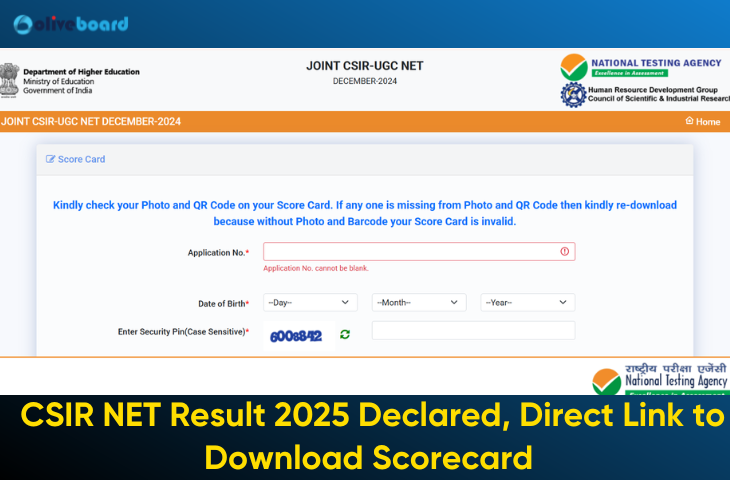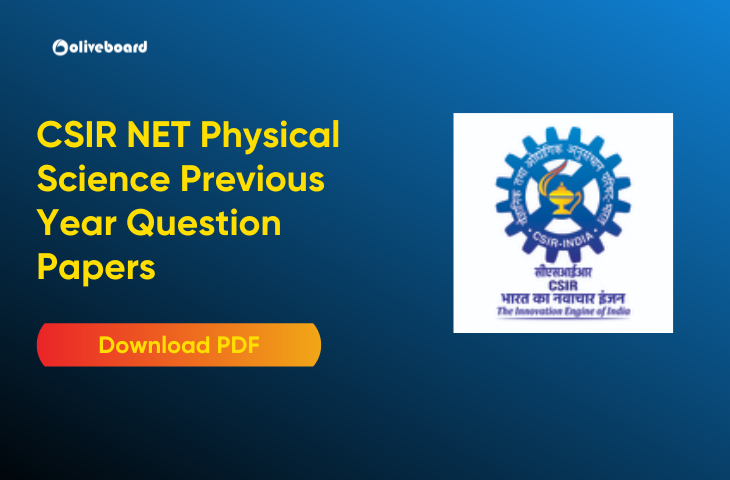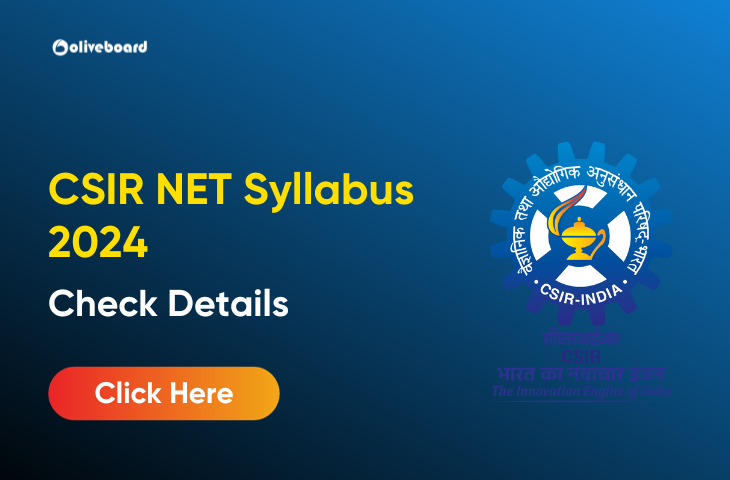CSIR NET Syllabus 2024
CSIR NET Syllabus 2024: The National Testing Agency has released the Latest CSIR NET Syllabus 2024 along with the latest CSIR Notification on the official website at https://csirnet.nta.nic.in/. The CSIR NET 2024 Syllabus comprises five subjects: life science, chemistry, physics, mathematics, and earth science papers. Candidates must cover topics from these subjects.
In this article, we have provided the complete details about the CSIR NET Syllabus and Exam Pattern and CSIR NET syllabus 2024 PDF for your reference.
CSIR NET Syllabus
CSIR NET 2024 Online Exam will consist of three parts. All the parts will consist of objective-type, multiple-choice questions. There will be no break between papers. The subject-wise scheme of examination is as per the details below.
As stated, the CSIR NET 2024 syllabus is divided into three parts:
Part A shall be common to all subjects. This part shall contain questions pertaining to General Aptitude with emphasis on logical reasoning, graphical analysis, analytical and numerical ability, quantitative comparison, series formation, puzzles, etc.
Part B shall contain subject-related conventional Multiple Choice questions (MCQs), generally covering the topics given in the CSIR UGC NET Syllabus.
Part C shall contain higher-value questions that may test the candidate’s knowledge of scientific concepts and/or application of the scientific concepts. The questions shall be of an analytical nature where a candidate is expected to apply the scientific knowledge to arrive at the solution to the given scientific problem.
Part A: General Science, Quantitative Reasoning & Analysis, and Research Aptitude
This part of the syllabus covers the following topics:
- General Science: This section includes questions on Physics, Chemistry, Biology, Mathematics, and Computer Science.
- Quantitative Reasoning & Analysis: This section includes questions on data interpretation, logical reasoning, and problem-solving.
- Research Aptitude: This section includes questions on research methodology, scientific writing, and communication skills.
Part B: Subject-related conventional MCQs
This part of the syllabus covers the following topics:
- Some common topics that are covered in most subjects include:
- Basic concepts of the subject
- Important theories and laws
- Mathematical tools and techniques
- Applications of the subject
Part C: Higher value questions that may test the candidate’s knowledge of scientific concepts and/or application of the scientific concepts
This part of the syllabus covers the following topics:
- Higher-level questions on the topics covered in Part B
- Questions that require the candidate to apply their knowledge of the subject to solve real-world problems
CSIR Subject Wise Syllabus 2024
The CSIR NET syllabus encompasses a wide range of scientific disciplines to test expertise across fundamental concepts and advanced applications.
The CSIR NET exam covers five key subject areas:
Life Sciences – Explore biological systems and processes like cellular organization and fundamental physiology.
Chemistry – Study the properties of matter through branches like organic, inorganic, physical, and analytical chemistry.
Physics – Uncover the mysteries of the universe through classical and quantum mechanics, electromagnetism, thermodynamics, and more.
Mathematics – Master numbers and equations including analysis, algebra, calculus, and differential equations.
Earth Sciences – Learn about the complexities of our planet like earth materials, surface features, and environmental systems.
CSIR NET Chemical Science Syllabus 2024
CSIR NET Chemical Science Syllabus: Part A
| Section | Skill Set | Topics |
|---|---|---|
| Graphical Analysis & Data Interpretation | Data Visualization & Analysis | Pie Charts, Line & Bar Charts, Graphs, Mode, Median, Mean, Measures of Dispersion (Range, Variance, Standard Deviation), Data Interpretation from Tables |
| Reasoning | Logical Thinking & Problem Solving | Puzzles, Series Formation, Clock & Calendar Problems, Direction & Distance Problems, Coding & Decoding, Ranking & Arrangement Problems |
| Numerical Ability | Quantitative Skills & Calculations | Geometry Problems, Proportion & Variation, Time & Work Problems, HCF & LCM, Permutation & Combination, Compound & Simple Interest |
CSIR NET Chemical Science Syllabus: Part B and C
| Sub-Discipline | Key Topics | Specific Areas of Focus |
|---|---|---|
| Organic Chemistry | – Common named reactions & rearrangements | Applications of organic synthesis, stereochemistry principles, asymmetric synthesis, chiral auxiliaries, resolution methods |
| – Determination of organic compounds | IR & UV-Vis spectroscopy, mass spectrometry techniques | |
| – Concepts in organic synthesis | Disconnection analysis, synthons, protecting groups, linear & convergent synthesis | |
| – Pericyclic reactions | Cycloaddition reactions, sigmatropic rearrangements, electrocyclization | |
| – Photochemistry | Applications and principles of photochemical reactions in organic chemistry | |
| Inorganic Chemistry | – Acid-base concepts | Non-aqueous solvents, hard-soft acid-base theory |
| – Organometallic compounds | Bonding, structure, reactivity, and synthesis of organometallics | |
| – Bioinorganic chemistry | Porphyrins, photosystems, oxygen transport, nitrogen fixation, metal complexes in medicine | |
| – Nuclear chemistry | Radio-analytical techniques like activation analysis, nuclear reactions, fission, and fusion | |
| – Inner transition elements | Redox chemistry, spectral and magnetic properties, analytical applications | |
| – Chemical periodicity | Periodic table, elements, groups, and their significance | |
| Physical Chemistry | – Chemical applications | Group theory, symmetry elements, character tables |
| – Solid-state | Bragg’s law and applications, band structure of solids, crystal structures | |
| – Polymer chemistry | Kinetics of polymerization, molar mass determination | |
| – Colloids and surfaces | Isotherms, surface area, heterogeneous catalysis, properties of colloids | |
| – Atomic structure | Spectroscopy, antisymmetry principle, many-electron systems | |
| – Data analysis | Absolute and relative errors, covariance & correlation coefficient, mean & standard deviation | |
| – Principles of quantum mechanics | Operator algebra, orbital & spin angular momenta, postulates | |
| – Chemical kinetics | Complex reactions, reaction mechanisms, steady-state approximation, empirical rate laws, temperature dependence, enzyme kinetics | |
| – Molecular spectroscopy | Basic principles of magnetic resonance, electronic spectra, rotational & vibrational spectra of diatomic molecules | |
| – Approximate methods of quantum mechanics | Perturbation theory, variational principle and its applications | |
| – Elementary concepts of MO and VB theories | Huckel theory, chemical bonding in diatomics | |
| – Electrochemistry | Ionic equilibria, conductometric & potentiometric titrations, Debye-Huckel theory | |
| Interdisciplinary Topics | – Environmental chemistry | Pollution control, green chemistry approaches |
| – Supramolecular chemistry | Host-guest interactions, molecular recognition | |
| – Chemistry in nanoscience & technology | Nanomaterials, synthesis, characterization, applications | |
| – Medicinal chemistry | Drug design, drug discovery, mechanisms of action | |
| – Catalysis and green chemistry | Catalytic principles, green chemistry strategies for sustainable processes |
CSIR NET Earth Science Syllabus 2024
CSIR NET Earth Science Syllabus: Part A
| Section | Sub-Topics | Specific Areas of Focus |
|---|---|---|
| Quantitative Aptitude | – Number Systems: Integers, Fractions, Decimals, Ratios, Proportions | Identifying types, operations, conversions, applications |
| – Algebra: Equations, Inequalities, Functions, Logarithms | Solving equations, understanding functions, using logarithms | |
| – Profit and Loss: Calculations, Percentages, Markups, Discounts | Determining gains/losses, calculating percentages, applying to business scenarios | |
| – Graphs: Interpretation of Line, Bar, Pie charts, data visualization | Extracting information, identifying trends, making comparisons | |
| – Permutations and Combinations: Arrangements, Selections, Probability | Counting possibilities, applying in different contexts | |
| – Area: Calculations for various shapes (triangles, rectangles, circles, etc.) | Applying formulas, solving area-related problems | |
| – Simple and Compound Interest: Calculations, Future Value, Present Value | Understanding financial concepts, applying formulas to investment scenarios | |
| – Average, Ratio and Proportion: Mean, Median, Mode, Ratios, Proportions | Calculating central tendency, comparing quantities, solving ratio problems | |
| Reasoning | – Similarities and Differences: Identifying commonalities and distinctions | Analyzing features, drawing conclusions |
| – Graphic Analysis: Interpretation of charts, graphs, diagrams | Understanding visual representations, extracting information | |
| – Analogies: Identifying relationships between concepts | Recognizing patterns, using reasoning to find similar relationships | |
| – Directions: Compass directions, Maps, Route planning | Understanding direction systems, solving path-finding problems | |
| – Coding-Decoding: Breaking and creating codes, understanding patterns | Identifying rules, applying logic to decode and encode messages | |
| – Data: Interpretation of tables, charts, graphs | Analyzing data, extracting insights, identifying trends | |
| – Analytical Reasoning: Logical deductions, problem-solving strategies | Analyzing information, drawing conclusions, making inferences | |
| – Symbols And Notations: Understanding and interpreting symbols used in the exam | Familiarizing with mathematical, logical, and graphical symbols | |
| – Non-Verbal Reasoning: Visual puzzles, patterns, sequences | Identifying spatial relationships, solving visual problems using logic | |
| – Number Series, Blood Relations, Visual Ability: Identifying patterns, understanding relationships, visualizing objects | Recognizing sequences, solving family relationship problems, interpreting visual stimuli | |
| Data Interpretation and Data Analysis | – Tabular and Graphical analysis: Interpretation of tables, charts, graphs | Extracting information, identifying trends, comparing data sets |
| – Mean, median and Mode: Calculations and applications of central tendency measures | Understanding and using different measures of central tendency, selecting appropriate measure for specific scenarios | |
| – Measures of dispersion: Range, Variance, Standard Deviation | Understanding variability in data, calculating and interpreting dispersion measures |
CSIR NET Earth Science Syllabus: Part B and C
| CSIR NET Part B and C | Topic | Sub-Topics |
|---|---|---|
| B: Environmental Earth Sciences | Natural hazards & risk assessment | Earthquakes, volcanoes, landslides, floods, droughts, climate change impacts |
| Pollution & environmental management | ||
| Land use & land cover change | ||
| Environmental laws & policies | ||
| Remote sensing & GIS applications | ||
| B: Earth and Solar System | Formation & evolution of the solar system | Origin of the sun, planets, and moons, solar wind, meteoroids & comets |
| Earth’s structure & composition | ||
| Astronomy & astrophysics | ||
| Geomagnetism & Earth’s magnetic field | ||
| The Sun & its influence on Earth | ||
| B: Interior of the Earth, Deformation & Tectonics | Earthquakes | Seismology, earthquake waves, magnitude & intensity, earthquake prediction & mitigation |
| Volcanism | ||
| Mountain building & plate tectonics | ||
| Rock deformation | ||
| Isostasy & gravitational anomalies | ||
| B: Earth Materials, Surface Features & Processes | Minerals & rocks | Igneous, sedimentary, & metamorphic rocks, rock cycle, mineral identification |
| Weathering & erosion | ||
| Geomorphology | ||
| Hydrology | ||
| Soils & soil science | ||
| B: Oceans & Atmosphere | Physical oceanography | Ocean currents, waves, tides, salinity, temperature, marine geology |
| Chemical oceanography | ||
| Marine biology & ecosystems | ||
| Atmospheric science | ||
| Climate change & global warming | ||
| C: Geography & Geophysics | Ocean Sciences | Physical, chemical, & biological oceanography, marine geology, ocean technology |
| Physical Geography | ||
| Meteorology | ||
| Geophysics | ||
| Geology |
CSIR NET Exam Pattern 2024
CSIR NET exam pattern is mentioned in the CSIR NET 2024 Notification, A total of 120 questions of 200 marks will be asked in the exam. Here’s the pattern of exam according to each subject.
Chemical Sciences
The exam pattern for the subject of Chemical Sciences is as follows.
| CHEMICAL SCIENCES | Part A | Part B | Part C | Total |
|---|---|---|---|---|
| Total Questions | 20 | 40 | 60 | 120 |
| Max Number of Questions to attempt | 15 | 35 | 25 | 75 |
| Marks for each correct answer | 2 | 2 | 4 | 200 |
| Negative marking | 0.5 | 0.5 | 1 | – |
Earth, Atmospheric, Ocean, and Planetary Sciences
The exam pattern for the subject of Earth, Atmospheric, Ocean, and Planetary Sciences is as follows.
| EARTH, ATMOSPHERIC, OCEAN, AND PLANETARY SCIENCES | Part A | Part B | Part C | Total |
|---|---|---|---|---|
| Total Questions | 20 | 50 | 80 | 150 |
| Max Number of Questions to attempt | 15 | 35 | 25 | 75 |
| Marks for each correct answer | 2 | 2 | 4 | 200 |
| Negative marking | 0.5 | 0.5 | 1.32 | – |
Life Sciences
The exam pattern for the subject of Earth, Atmospheric, Ocean, and Planetary Sciences is as follows.
| LIFE SCIENCES | Part A | Part B | Part C | Total |
|---|---|---|---|---|
| Total Questions | 20 | 50 | 75 | 145 |
| Max Number of Questions to attempt | 15 | 35 | 25 | 75 |
| Marks for each correct answer | 2 | 2 | 4 | 200 |
| Negative marking | 0.5 | 0.5 | 1 | – |
Mathematical Sciences
The exam pattern for the subject of Mathematical Sciences is as follows.
| MATHEMATICAL SCIENCES | Part A | Part B | Part C | Total |
|---|---|---|---|---|
| Total Questions | 20 | 40 | 60 | 120 |
| Max Number of Questions to attempt | 15 | 25 | 20 | 60 |
| Marks for each correct answer | 2 | 3 | 4.75 | 200 |
| Negative marking | 0.5 | 0.75 | 0 | – |
Physical Sciences
The exam pattern for the subject of Physical Sciences is as follows.
| PHYSICAL SCIENCES | Part A | Part B | Part C | Total |
|---|---|---|---|---|
| Total Questions | 20 | 25 | 30 | 75 |
| Max Number of Questions to attempt | 15 | 20 | 20 | 55 |
| Marks for each correct answer | 2 | 3.5 | 5 | 200 |
| Negative marking | 0.5 | 0.875 | 1.25 | – |
The test will be in Hindi and English version. In case of any ambiguity between the Hindi and English version due to translation, the English version would be treated as final.
CSIR NET Syllabus 2024 – Frequently Asked Questions
A1. CSIR NET is conducted for JRF and Lecturership in Chemical Sciences, Earth Sciences, Life Sciences, Mathematical Sciences, and Physical Sciences.
A2. The CSIR NET exam is 3 hours long.
A3. CSIR NET exam has 120 multiple choice questions (MCQs).
A4. The marking scheme for CSIR NET has 3 parts – Part A: 2 marks per question, Part B: 2 marks per question, Part C: 4 marks per question.
A5. Yes, 0.25 marks are deducted per wrong answer.
A6. The minimum qualifying marks for CSIR NET is 33% for General, EWS and OBC category, and 25% for SC, ST and PwD candidates.
A7. The CSIR NET syllabus and exam pattern can be found on the official website of the National Testing Agency (NTA).
- CSIR NET vs DBT JRF vs ICMR JRF, Which One is Best for Research?

- CSIR NET Result 2025 Declared, Direct Link to Download Scorecard

- CSIR NET December Admit Card 2024 Out, Download Now

- CSIR NET Exam Pattern & Marking Scheme 2025, Detailed Breakdown

- CSIR NET vs GATE, Best Exam for Career Growth & Opportunities

- CSIR NET Physical Science Previous Year Question Papers, PDF Download

Hi, I’m Tripti, a senior content writer at Oliveboard, where I manage blog content along with community engagement across platforms like Telegram and WhatsApp. With 3+ years of experience in content and SEO optimization related to banking exams, I have led content for popular exams like SSC, banking, railways, and state exams.
